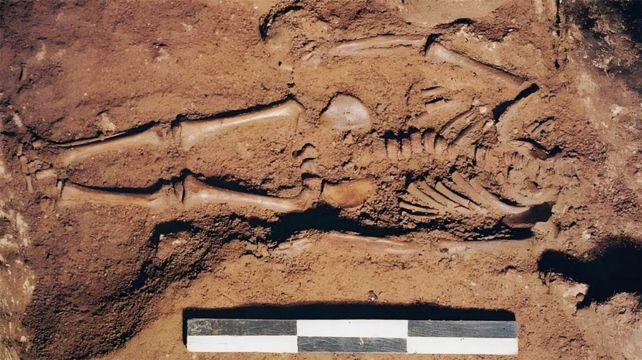Products You May Like
An unlucky child born with a heart condition 17,000 years ago also had the earliest known instance of blue eyes.
Based on genetic data from his remains, found in what’s now Italy, “the infant most likely had blue eyes, dark skin, and curly dark brown/almost black hair,” University of Bologna archeologist Owen Higgins and team write in their paper.
Like many in the Paleolithic period, the ice age child lacked the genes that would have allowed him to digest milk as an adult. He also likely had unusually thickened heart muscles, caused by a typically inherited condition.
Measuring a mere 82 centimeters (32 inches) in length, the remains suggest a life cut short, with his age at death estimated between 7.5 and 18 months.
Histological analysis of the infant’s teeth and a healed fracture on his collarbone indicated he had a tough birth and had already experienced other stresses too.
“The analyses revealed a slightly earlier development than the average of modern European populations and at least nine episodes of physiological stress, three of which occurred during intra-uterine life,” says Higgins.
The stress markers align with the genetic findings that suggest the child had hypertrophic cardiomyopathy, a congenital heart disease linked to sudden death in youth.
The infant’s mother likely endured some stresses during her pregnancy, and may have been malnourished. An isotopic analysis suggests she stayed put in one place during at least the final period of her pregnancy. This was in the same area the child was born and lived his short life.
Archaeologists from the University of Siena discovered the prehistoric child’s skeletal remains in 1998. They were found tucked away, without any final possessions or adornments, behind rock slabs in the Grotta delle Mura cave of Monopoli, Puglia, on Italy’s southwest coast.

“Genetic analysis highlighted a close relationship between the child’s parents, suggesting that they were probably first cousins,” explains University of Florence molecular anthropologist Alessandra Modi, “a phenomenon rarely found in the Paleolithic, but more common during the Neolithic.”
Blue eyes arise from a mutation in the gene OCA2, dialing down our body’s ability to produce the melanin pigment for brown eyes. A mutated OCA2 gene was also detected in the ice-age boy.
Genetic analysis suggests all blue-eyed humans today, which can now make up up to 40 percent of some current European populations, can be traced back to a single mutation that arose in Europe between 6,000 and 10,000 years ago.
The previous oldest known blue-eyed individual was from around 14,000 years ago, known as the Villabruna man. The eye color and other genetic similarities suggest the boy’s people may have been the Villabruna man’s ancestors.
This research was published in Nature Communications.
